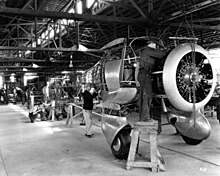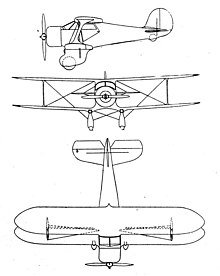Beechcraft Model 17
| Beechcraft Model 17 Staggerwing | |
|---|---|
 D.17S at a veterans' meeting in England |
|
| Type: | Business jet |
| Design country: | |
| Manufacturer: | |
| First flight: |
November 4, 1932 |
| Commissioning: |
1933 |
| Production time: |
1932 to 1949 |
| Number of pieces: |
785 |
The Beechcraft Model 17 Staggerwing is a double-decker from the manufacturer Beechcraft .
history
The first Beech 17 flew on November 4, 1932. The sales prices ranged between 14,000 and 17,000 US dollars, depending on the engine (225–450 hp). Every single machine was built by hand and according to the wishes of the buyer. The Beech got the nickname Staggerwing after a spokesman reported on the tiered arrangement of the wings at an air show (from English stagger - staggering).
With their staggerwing, Louise Thaden and Blanche Noyes became the first women to win the Bendix Trophy , a transcontinental air race from New York to Los Angeles. Staggerwing production ended in 1948 with the D17 G. The manufacture was too expensive, and Beech started a line with the all-metal Beechcraft Bonanza that is still being built today.
construction
The aircraft has a radial engine , retractable landing gear with a tail wheel and good aerodynamics. The wings of this type are arranged differently than most biplanes: the lower surface lies in front of the upper surface. This construction ensures that both wings never stall at the same time. The cruising speed is 280 km / h (150 kn) with up to five people on board, the service ceiling is 8000 meters. With the mechanically charged Pratt & Whitney radial engine Wasp Junior , the aircraft has a range of over 1,600 kilometers. It has a consumption of about 90 liters per hour. The flight behavior of the aircraft is very stable.
use
In 1935, Captain Farquhar flew around the world in a model B 17 R, partly on floats, the Staggerwing was also available as a seaplane, and later with the normal landing gear. He covered 21,332 miles and flew from New York via Canada, Alaska, Russia, China, Siam, Iraq, Egypt, Tripoli and France.
The Staggerwing was "the pre-war Learjet " and was used by many companies to transport their executives. During the Second World War, the Staggerwing was also used by the British Royal Air Force . The 106 machines delivered were given the name Traveler .
The US Navy and the US Army also used Staggerwings under the designations GB-1, GB-2 and UC-43. The code letter "G" stood in the US Navy from 1939 to 1941 for single-engine transport aircraft . Today there are still about 200 machines in the hands of collectors and enthusiasts worldwide, of which about 160 are ready to fly.
Technical specifications

| Parameter | Data of the Beech model G17S |
|---|---|
| Crew / passengers | 4-5 |
| length | 8.15 m |
| span | 9.75 m |
| height | 2.44 m |
| Wing area | 27.65 m² |
| Empty mass | 1270 kg |
| Max. Takeoff mass | 1928 kg |
| drive | a Pratt & Whitney R-985 -AN-4 Wasp Junior radial engine with 336 kW (450 hp) |
| Top speed | 341 km / h |
| Economy flight speed in 2895 m | 298 km / h |
| Max. Range | 1609 km |
See also
literature
- Dornier Foundation for Aviation and Space Travel (Ed.): Dornier. Plant history and aircraft types . 2nd revised edition. Delius Klasing, Bielefeld 2009, ISBN 978-3-7688-2610-5 , p. 89 .
- Leonard Bridgman (Ed.): Jane's All The World's Aircraft 1945-1946. Samson Low, Marston & Company, Ltd., London 1946, pp. 200c f.
Web links
- http://www.beechcraftheritagemuseum.org/collection/NC499N.html
- http://www.centennialofflight.gov/essay/GENERAL_AVIATION/staggerwing/GA11.htm
- http://www.nasm.si.edu/collections/artifact.cfm?id=A19810023000

